Cleaner Snail Profile – Types of Aquarium Snails
You can only keep fish in your tanks? No. Exactly, aquarium snails are another excellent option. Have you ever heard about that? Some aquarium snails are helpful to remove algae and clean up your fish tank. If you know little about them at present, it does not matter, let’s get into a deeper learning about aquarium snails in today’s article. Without any more delay, let’s get started.
Content Table
Aquarium snails
Are snails aquarium pets or aquarium pests? In fact, it depends on the snail species. Some are safe for your tank, while others may be damaging to your aquarium. For instance, some aquarium snails may eat fish or vice versa. On the other side, aquarium snails are not all bad. Exactly, some are beneficial. They are helpful to remove unnecessary or harmful debris and waste, as well as dead plants leaves, and algae.
Then, how can the aquarium snails get into your fish tank? They enter your tank by attaching to aquatic plants. Because snails’ eggs and the young aquarium snails always possess translucent shells, which makes they are hard to be found. Also, you may manually introduce some beneficial snails to your aquariums.
Types of aquarium snails
Usually, aquarium snails are classified into two types – beneficial aquarium snails and harmful aquarium snails. Next, we will list some of these two types of aquarium snails.
Beneficial aquarium snails
- Nerite snails
- Mystery snails
- Black devil snails
- Ivory snails
- Assassin snails
- Rabbit snails
- Japanese trapdoor snails
- Ramshorn snails
- Bladder snails
- Apple snails
- Brotia pagodula snails
- Gold Inca snails
- Pagoda snails
- Tower cap snail
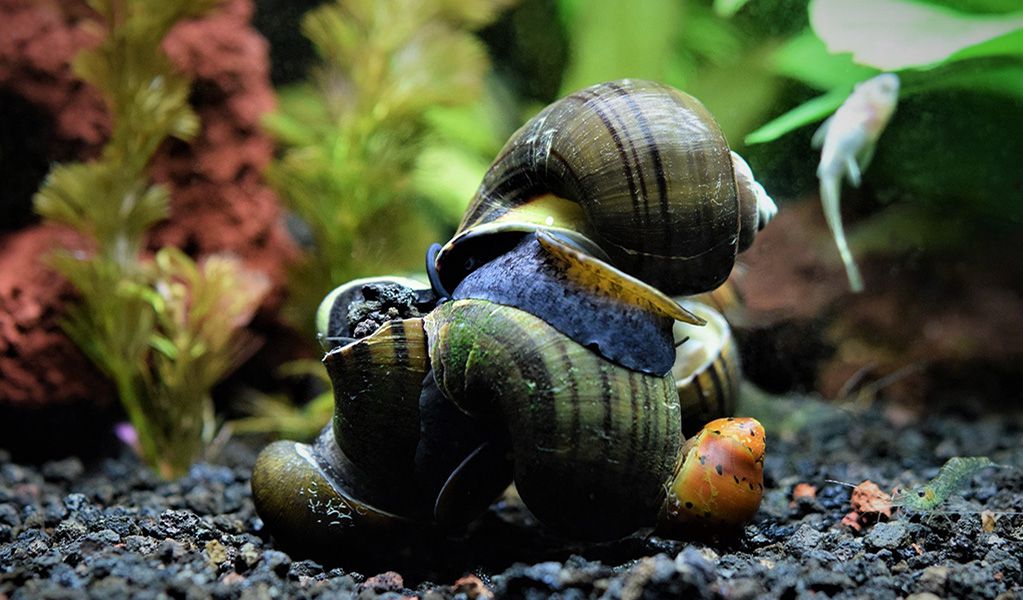
Harmful aquarium snails
- Malaysian trumpet snails
- Pond snails
- Trumpet snails
- Bumble bee snails
- Murex snails
- Crown conchs
- Keyhole limpets
Aside from that, we will share some common freshwater aquarium snails, including basic information, as well as pros and cons.
Nerite snails
Nerite snails, like tiger nerite snails, zebra nerite snails, and Horned nerite snails, are popular ones. They can be kept in freshwater and saltwater. Actually, nerite snails are great algae eaters. Additionally, there are some pros and cons of nerite snails:
Pros:
- Great algae eaters
- Peaceful
- Do not eat plants
Cons:
- Unable to reproduce in freshwater aquarium
- Go out from the aquarium
|
Scientific name |
Neritina natalensis |
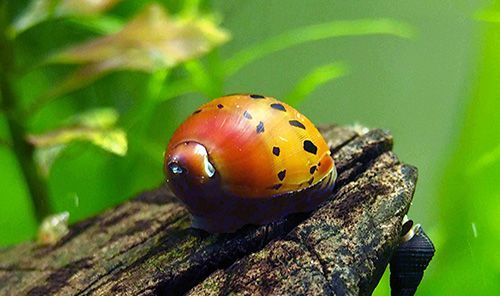 |
|
Size |
1 inch in diameter |
|
|
Diet |
Omnivores |
|
|
Water temperature |
71-79℉ |
|
|
pH level |
8.0-8.4 |
|
|
Minimum tank size |
5 gallons |
Mystery snails
Mystery snails come in diverse shell patterns and colors, like black, white, gold, and blue. However, they may eat a lot and produce many feces, which can be a food source for fish fry and young shrimp. Additionally, there are some pros and cons of mystery snails:
Pros:
- Hardy, active, and easy to care for
- Great algae eaters and aquarium cleaners
- Peaceful
Cons:
- Go out from the aquarium
- Lay eggs on the water’s surface
|
Scientific name |
Pomacea bridgesii |
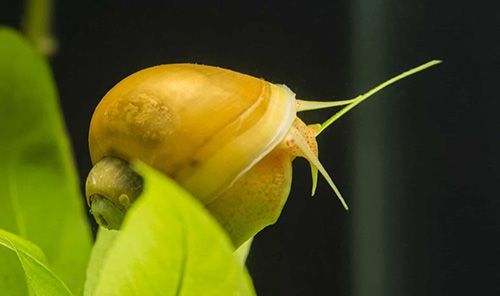 |
|
Size |
2 inches in diameter |
|
|
Diet |
Omnivores |
|
|
Water temperature |
68-82℉ |
|
|
pH level |
7.6-8.4 |
|
|
Minimum tank size |
5 gallons |
Black devil snails
Black devil snails are large aquarium snails, which can be kept both in freshwater and saltwater aquarium. Nevertheless, may be difficult to breed. Accordingly, black devil snails would not overpopulate your tank. In addition, there are some pros and cons of black devil snails:
Pros:
- Hardy, active, and easy to care for
- Great algae eaters and aquarium cleaners
- Peaceful
Cons:
- Only reproduce in brackish water
- Eat aquatic plants when hungry
|
Scientific name |
Faunus Ater |
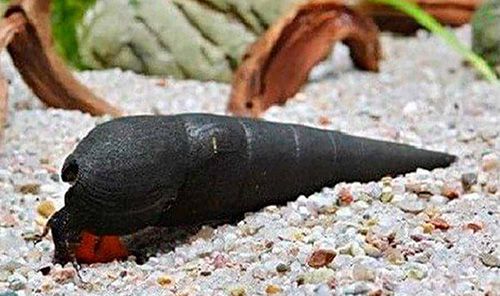 |
|
Size |
2-3 inches |
|
|
Diet |
Omnivores |
|
|
Water temperature |
71-82℉ |
|
|
pH level |
7.0-8.5 |
|
|
Minimum tank size |
10 gallon |
What do fish tank snails eat
Now that some aquarium snails are helpful, what do they eat in a fish tank? Actually, there are many available food choices for aquarium snails: algae, uneaten food, vegetables, and fruits, rotted or dead plants, bloodworms, earthworms, brine shrimp, and commercial snails food (e.g. fish pellet and shrimp pellet). However, the food needs may be a little bit different in diverse snail species. Next, we will cover some info about it.
- Herbivores snails: algae, organic debris, bacteria on the substrate and rocks, decaying or dead plants, fish food, uneaten food
- Carnivores snails: bloodworms, earthworms, small brine shrimp, feeder snails, pellets
- Detritivores snails: almost anything available in the aquarium
- Omnivores snails: algae, carrots, peas, watermelon, apple, decaying or dead plants, blood worms, brine shrimp, shrimp pellets
In addition, some food should be avoided, like artificial colors, flavors, and poultry. By the way, it is recommended to feed the aquarium snails twice a day. And you should make sure that they can finish eating within 2–3 minutes.
Do snails need warm water?
Aquarium snails can not regulate their body temperature and require an ideal water temperature of 64-83℉. And whether should you add an aquarium heater is determined by the living environment. Nevertheless, it is best to add one to reduce the risk of water temperature drops suddenly, especially on winter days. An aquarium heater can reduce water temperature changes and maintain a stable water temperature. As a result, the waste in your tank would be reduced accordingly. Because a too-high water temperature would accelerate the metabolism and produce more waste. While lower water temp would cause less active snails but would extend their lifespan.
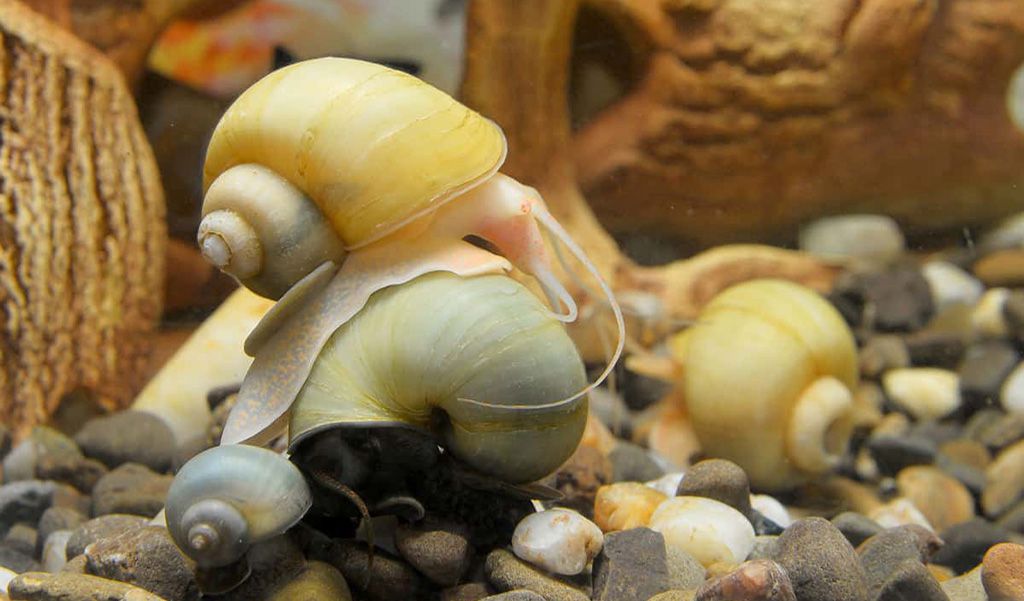
Is there any benefit to having snails in a fish tank
Though holding aquarium snails may harm your fish tank, it is also beneficial. In this segment, we will share the benefits and faults of keeping aquarium snails in a fish tank.
The benefits of having aquarium snails in a fish tank
Aquarium snails can be aquarium cleaners, and make sense in removing waste, unnecessary substances, uneaten food, algae, and something like this. Consequently, it helps to keep clean fish tanks. Besides that, some snail would dig the substrate and their feces can supplement nutrients for plants. Furthermore, most aquarium snails are hardy and easy to care for.
The faults of having aquarium snails in a fish tank
Snail breeding may lead to overstock and imbalance in your tank. And snails and snail eggs would stick on the aquarium glass, which decreases the ornamental value of the aquarium. Moreover, some freshwater snails may eat live aquatic plants. But it is not common. Anyway, facing these bad situations, you’d better not keep snails in your tank.
Reminder
Finally, here are some tips for aquarium snails’ daily maintenance. On the one hand, inappropriate tank mates should be avoided. Some fish would eat snails, while some snails also eat fish. Hence, you should consider the compatibility of tank mates before adding to your aquarium. Take fish as an example, dwarf chain loaches, and catfish would eat aquarium snails.
On the other hand, you would need to remove the harmful aquarium snails sometimes. Then, how to remove the harmful aquarium snails? You can create a trap, and lure them with food. Once they enter the trap, you can remove them. Additionally, add some fish that eat snails, such as freshwater puffer fish, Oscars, clowns, and zebra. Furthermore, snail removal solutions are another alternative. But it is best not to add the solution while there are other live creatures in the aquarium. Otherwise, these creatures may face death.
